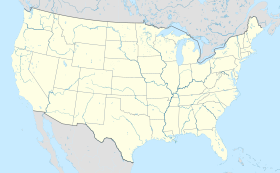Confederate Private Monument
| Confederate Private Monument | |
|---|---|
 | |
| Artist | George Julian Zolnay |
| Year | 1909 |
| Medium | Bronze sculpture |
| Location | Nashville, Tennessee, United States |
| 36°8′52.37″N 86°48′45.39″W / 36.1478806°N 86.8126083°W | |
The Confederate Private Monument is a bronze sculpture of a private of the Confederate States Army in Centennial Park, Nashville, Tennessee, United States. Designed by George Julian Zolnay, it was commissioned by the Frank Cheatham Bivouac of the United Confederate Veterans in 1903, laid with Masonic honors in 1907, and dedicated in 1909. It was vandalized in June 2019.
Description
[edit]The monument consists of a statue of a Confederate private in a uniform with a rifle.[1] According to the Smithsonian Institution, the private is Sam Davis[2] (although newspaper articles published at the time do not mention him). The Smithsonian adds, "The butt of the rifle rests on the rocky stone ledge on which Davis is seated. He faces forward with his proper left hand resting between his knees. Davis is seated on a rough-cut stone atop a tapering base."[2] The monument includes a plaque with the names of 540 members of the Frank Cheatham Bivouac.[3]
History
[edit]Theodore Cooley, a member of the Frank Cheatham Bivouac of the United Confederate Veterans, suggested commissioning a monument in 1902.[1][4] By 1903, he assembled a group of Confederate veterans to work on the project, and they hired sculptor George Julian Zolnay, who had designed many other Confederate sculptures, to do it.[4][2][5] When Cooley died, Major B. M. Hord became the chairman of the committee.[4]
The monument cost $4,000 to build.[1][4] Zolnay donated $500; the Frank Cheatham Bivouac of the United Confederate Veterans raised $1000, the United Daughters of the Confederacy raised more than $1,000, and the rest was covered by smaller donors.[4][3] By 1907, the cornerstone was "laid with Masonic honors by the Grand Lodge of the State."[4] The monument also includes a plaque with the names of 540 members of the Frank Cheatham Bivouac.[3]
The monument was dedicated in Centennial Park on June 19, 1909.[2][6] Henry Watterson gave a speech that celebrated Tennessee for having the courage to leave the Union and stated "Greece had its Marathon; let Shiloh, Murfreesboro and Chichamauga tell the story of Tennessee." Zolnay gave a speech in front of the crowd highlighting that his wife was a Southerner, and Judge S. F. Wilson gave another speech about the fighting spirit of the private soldier in the CSA.[4] It was "unveiled in the presence of an immense crowd of people,"[6] to the sound of "Dixie".[4]
In a speech, Henry Watterson combined a veneration of Southern glory with a consecration of the dead to the reconciliation of the living. Although he emphasized divine will, he differed from other United Confederate Veteran speakers in that he depicted God sacrificing the men of both sections to a new Union. Through veneration of things memorable, magnificent, and courageous, he aroused feelings of pride, patriotism, and loyalty to the new Union. In appealing to things memorable, he transferred elements of the Gospels to Southern history to heighten the sense of divine destiny in reconciliation. He recounted the magnificence and courage of Tennesseans to highlight their conduct in war and their conciliatory spirit in peace.[7]
Vandalism
[edit]The statue was vandalized with red paint on June 17, 2019.[1][5][8] The vandal(s) also painted "THEY WERE RACISTS" on the plaque with the names of the 540 Confederate veterans.[5][9]
References
[edit]- ^ a b c d Dance, Brooklyn (June 18, 2019). "Vandalized confederate monument in Centennial Park had kept low profile before Monday". The Tennessean. Retrieved June 19, 2019.
- ^ a b c d "Confederate Private Monument, (sculpture)". The Smithsonian Institution. Archived from the original on September 6, 2017. Retrieved September 6, 2017 – via Wayback Machine.
- ^ a b c Losson, Christopher (1989). Tennessee's Forgotten Warriors: Frank Cheatham and His Confederate Division. Knoxville, Tennessee: University of Tennessee Press. p. 286. ISBN 9780870496158. OCLC 19742044.
frank cheatham bivouac.
- ^ a b c d e f g h "TRIBUTE PAID RANK AND FILE". The Tennessean. June 20, 1909. pp. 1–2. Archived from the original on June 24, 2019. Retrieved September 6, 2017 – via Newspapers.com.
- ^ a b c Epstein, Kayla (June 18, 2019). "'They were racists': Confederate monument in Nashville sprayed with blood-red graffiti". The Washington Post. Retrieved June 19, 2019.
From its plinth, the bronze Confederate soldier watched the coming and going of the Jim Crow era, during which African Americans were barred from using the pool in Centennial Park.
- ^ a b "Confederate Privates' Monument". The Houston Post. June 20, 1909. p. 2. Retrieved September 6, 2017 – via Newspapers.com.
- ^ George Christopher Wharton (1974). "Henry Watterson, A Study of Selected Speeches on Reconciliation in the Post-Bellum Period" (PDF). doi:10.31390/gradschool_disstheses.2770. S2CID 148792064. Archived from the original (PDF) on 2020-02-27.
- ^ Dance, Brooklyn (June 17, 2019). "'They were racists': Confederate monument found vandalized in Centennial Park". The Tennessean. Retrieved June 19, 2019.
- ^ Golgowski, Nina (June 18, 2019). "Confederate War Monument Vandalized To Read 'They Were Racists'". The Huffington Post. Retrieved June 19, 2019.
- 1909 establishments in Tennessee
- 1909 sculptures
- Bronze sculptures in Tennessee
- Buildings and structures in Nashville, Tennessee
- Confederate States of America monuments and memorials in Tennessee
- Monuments and memorials in Tennessee
- Outdoor sculptures in Tennessee
- Sculptures of men in Tennessee
- Statues in Tennessee
- Vandalized works of art in Tennessee


